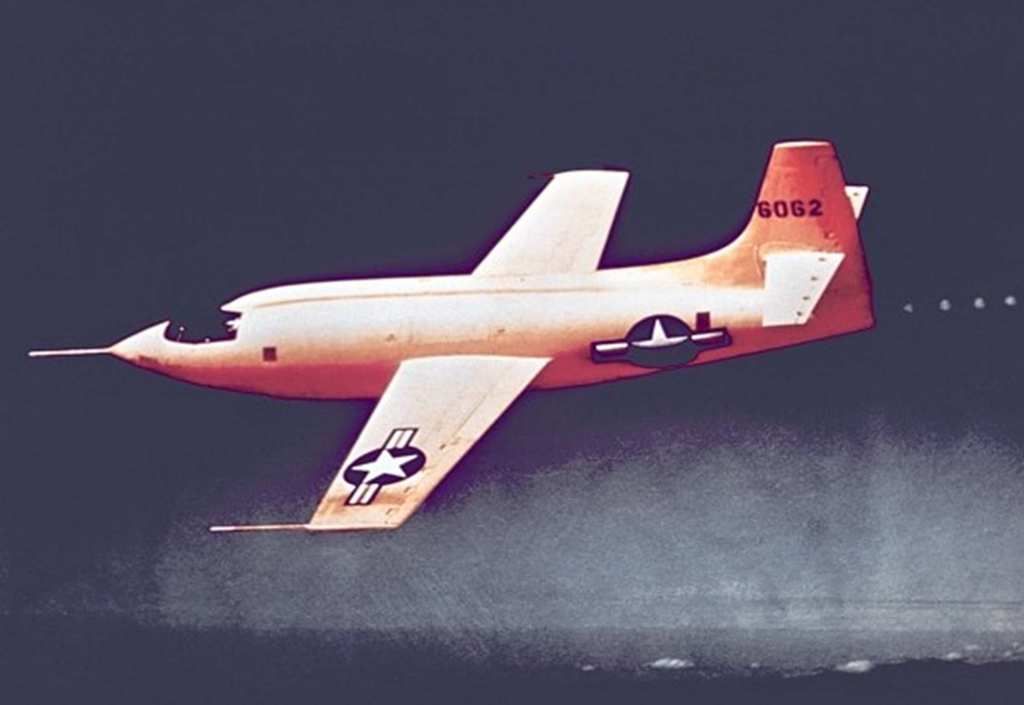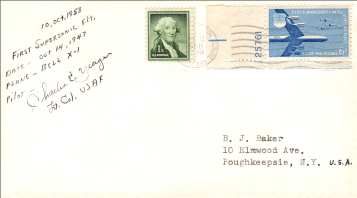|
|

|
|
Author
|
Topic: Space Cover 393: The Flight of XS-1
|
stevedd841
Member Posts: 299
From: Millersville, Maryland
Registered: Jul 2004
|
 posted 11-27-2016 05:52 AM
posted 11-27-2016 05:52 AM
   
Space Cover of the Week, Week 393 (November 27, 2016) Bell XS-1 experimental aircraft in flight showing shock diamonds from rocket exhaust, photo credit USAF Lt. Robert A. Hoover/NASA-Armstrong.Space Cover #393: The Flight of XS-1 An experienced test pilot, he already had made 26 flights in the Bell X-1 rocket plane and now was slated to make the research aircraft's first supersonic flight, but it never happened. "Slick" Goodlin had requested a flight bonus of $150,000 from Bell Aircraft to pilot this unprecedented historic flight. It was an incredible amount of money for a test pilot to request, but it was also a dangerous and historic flight that had never been accomplished. Bell Aircraft managers refused Goodlin's request, and the U.S. Air Force designated Captain Charles "Chuck" Yeager to take over the scheduled Bell X-1 flight to attempt to break the unattainable sound barrier.
On October 14, 1947, after dropping from the B-29 mothership that had carried him to his flight altitude at 20,000 feet, Chuck Yeager felt his rocket engine kick-in and intently watched his airspeed indicator as he rocketed away from the B-29 aircraft, "Suddenly the Mach needle began to fluctuate. It went up to .965 Mach—then it tipped right off the scale. I thought I was seeing things! We were flying supersonic! And it was as smooth as a baby's bottom..." Yeager had broken the sound barrier in his Bell XS-1 supersonic aircraft at Mach 1.06, 761 miles per hour, at 20,000 feet altitude, over Muroc Army Air Field, California. For the flight, Yeager was paid his regular U.S. Air Force Captain's pay of $3,396 per year. Furthermore, he received no hazardous pay for his flight. That night, celebrating the flight over a pitcher of martinis at the Muroc Air Field Officers' Club, his buddies chided him about his breaking the sound barrier and being "the fastest man alive." But his flight remained classified as top secret until the popular aviation trade magazine "Aviation Week" broke the story in December 1947. Military officials did not confirm Yeager's top secret, record-breaking sound barrier flight until several months later, in May 1948. By way of historical perspective, with aircraft flying faster and faster in the late 1930s and 1940s, pilots had experienced many problems caused by increased airspeed. High performance aircraft including the Lockheed P-38 "Lightning" and Republic P-47 "Thunderbolt" flew well at operational airspeeds in level flight. In high-speed dives or other high speed maneuvers though, pilots had experienced aircraft control problems that were unexpected. An aerodynamic condition recognized as "compressibility" was identified as causing this problem. As the speed of sound was approached, air density increased due to air molecules impinging upon the aircraft and air molecules could not be pushed out of the way fast enough. Shock waves then formed around the aircraft affecting both lift and drag as air speed increased further. In this early period, air density change due to compressibility was not well understood, and it precipitated loss of aircraft and deaths of test pilots encountering this poorly understood transonic situation.
What made the Bell XS-1 research aircraft different in handling this problem were structural and aerodynamic modifications using extremely thin but strong wing sections and employing horizontal stabilizers that could be adjusted either up or down to improve aircraft control. This XS-1 capability was especially significant at transonic air speeds, that is, speeds near the speed of sound or Mach 1. The XS-1 fuselage additionally was designed to conform to the shape of a Browning .50-caliber bullet with a windscreen also flared to maintain its bullet-like shape. The supersonic aircraft was occasionally referred to as a "bullet with wings." Additionally, the aircraft carried approximately 500 pounds of test instruments to record flight performance. As a result of Bell Aircraft's innovative aircraft design and operational performance success, follow-on military aircraft manufacturers incorporated similar design modifications including movable horizontal stabilizers as standard aircraft equipment for high performance aircraft.  A plain cover in Yeager's handwriting is shown from the author's collection for Chuck Yeager's supersonic flight in the Bell XS-1 rocket plane with the cover autographed by the pilot. Yeager's epic flight was made despite his having received two fractured ribs the previous weekend horseback riding. He was determined his broken ribs would not prevent him from making his flight. He had to use a sawed-off broom handle to close his hatch before the flight.
History would record Captain Chuck Yeager's incredible test flight in XS-1 breaking the sound barrier as follows: On 14 October 1947, just under a month after the United States Air Force had been created as a separate service, the tests culminated in the first manned supersonic flight, piloted by Captain Charles "Chuck" Yeager in aircraft #46-062, which he had christened Glamorous Glennis after his wife. The rocket-powered aircraft was launched from the bomb bay of a specially modified B-29 and glided to a landing on a runway. XS-1 flight number 50 is the first one to achieve the X-1 recorded supersonic flight speed, at Mach 1.06 (361 m/s, 1,299 km/h, 761 mph) peak speed. And all of this accomplished on an Air Force Captain's pay. — Steve Durst SU 4379 |
micropooz
Member Posts: 1701
From: Washington, DC, USA
Registered: Apr 2003
|
 posted 11-27-2016 07:32 AM
posted 11-27-2016 07:32 AM
   
Great topic, Steve! And one that’s near-and-dear to my heart. Here are a couple of my favorite XS-1 related covers in two different flavors... The ultimate XS-1 cover would be one that was postmarked at Muroc on October 14, 1947, the date of Yeager’s supersonic flight. But in umpty-three years of collecting, I have yet to see or hear of one. The above is as close as I’ve gotten. This card was postmarked at nearby Mojave, CA, on October 3, 1947, the date Yeager flew the XS-1 to Mach 0.92 (92% of the speed of sound) in a warmup to his Mach 1 flight on October 14.  Anniversary covers for Yeager’s Mach 1 flight abound. Above is my favorite. It was postmarked at Edwards on the 50th anniversary, October 14, 1997, the same day that USPS issued a stamp commemorating the event, hence the first-day-of-issue postmark. And it was flown over Edwards that day at Mach 1 by Yeager in an F-15 fighter jet. Philip Dockter designed the cachet and facilitated the postmarking and flight of 1000 of these covers to help raise money for the Flight Test Historical Foundation Museum at Edwards. |
stevedd841
Member Posts: 299
From: Millersville, Maryland
Registered: Jul 2004
|
 posted 11-30-2016 07:01 PM
posted 11-30-2016 07:01 PM
   
Dennis, love seeing your Muroc postcard and agree that this Muroc postcard may be as close as anyone can get to the XS-1 test flight with Chuck Yeager breaking the sound barrier and living to talk about it. Many thanks for contributing both of your covers for my posting of this historic event. |
onesmallstep
Member Posts: 1421
From: Staten Island, New York USA
Registered: Nov 2007
|
 posted 12-01-2016 09:11 AM
posted 12-01-2016 09:11 AM
   
Nice to see an historic event remembered by unique and scarce covers. The Lt. Hoover who took the photo above is of course pilot extraordinaire Bob Hoover, who recently went west. He was Yeager's backup for the historic flight and flew chase.It should be noted; one of the few people living who witnessed the flight almost seventy years ago is Brig. Gen. Robert Cardenas (ret.), still with us at age 96, who was chief B-29 carrier pilot and dropped Yeager aboard the XS-1 that day. He was also pilot of the Northrop YB-49 flying wing. After sharing his concerns over the experimental plane's bad stalling qualities with Capt. Glen Edwards, he later sadly got the news that Edwards died piloting the plane. Muroc Field was then changed to Edwards in his honor. | |
Contact Us | The Source for Space History & Artifacts
Copyright 2023 collectSPACE.com All rights reserved.

Ultimate Bulletin Board 5.47a
|
|

|
 advertisement advertisement

|















